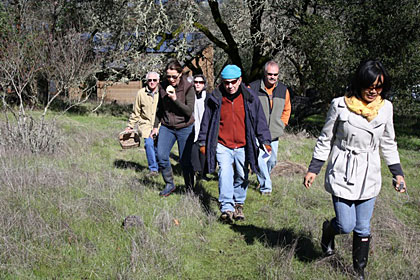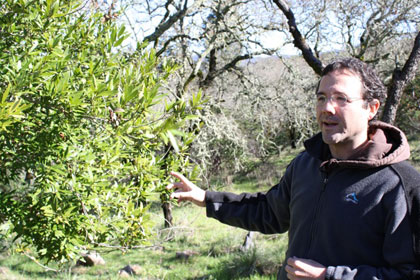
So far, the day had a couple of things going for it: warm, sunny weather and spectacular scenery. This is what I was thinking as I tramped over hill and dale preparing myself to eat whatever flora could be plucked from the Glen Ellen property we were foraging. The “we” turned out to be myself and 11 other eager but somewhat naïve souls led by master forager Kevin Feinstein and hosted by Junipero and Co.’s intrepid Kristin Viguerie, also The Sun’s food columnist.
Feinstein is a self-taught forager who leads wild edible food walks all over the Bay Area including, quite frequently, San Fransico’s Golden Gate Park. His goal has always been to acquaint people with the wild food that is all around them. If Viguerie’s almost constant refrain of, “Can we eat it?” was any indication, our group was itching to learn.
Upon arriving at the sprawling hillside acreage of Elisa and Chuck Stancil, Feinstein set out on a quick reconnaissance tour before addressing our group. Quantifying the forage first by stating that we’d missed the small seasonal window for many wild edibles, Feinstein quickly quashed hopes of finding any of the highly coveted chanterelle mushrooms a few people had come to find.
We set off nonetheless, moving in fits and starts as we stopped frequently to discuss what could be foraged from, say, a bay tree. Not what you’d expect. According to Feinstein, this evergreen is one of the most common in the Bay Area and is also one of his favorite trees. He first pointed out that bay leaves from our local trees are three times stronger than the more common Turkish variety found in supermarkets. But besides cooking, there are other things that the leaves can be used for as well. Highly pungent, they also function as a natural bug repellent outdoors or even inside – like mothballs, only better.
But using the leaves is a no brainer. Feinstein next told of numerous other things to eat on this one tree. First, the flower buds themselves are edible and we lined up to taste the tiny blossoms with a spicy flavor similar to cardamom. Earlier in the fall, before the flowers open, tiny green balls on the tree can either be eaten raw or pickled like capers. We missed out on this taste sensation, likewise the actual fruit of the bay tree, which is similar in appearance to a tiny avocado. Feinstein told us about the nut inside the fruit, which must be roasted after harvesting – a tricky job – tastes just like a coffee bean. Perhaps the next taste sensation to hit the market?
Throughout the morning, Feinstein waxed poetic on everything from Madrone berries, to acorn flour, from the bulbs, shoots and flower seeds eaten by Native Americans, to Toyon berries and various mushrooms, grasses and edible greens. We picked, we shared, we tried, we discussed and then we retired for a lovely picnic of cheeses, duck liver mousse, quiche, cupcakes, wine, and more – none of which had been procured on our forage but was delicious nevertheless. Best of all, we learned of the many, many unusual and edible things that grow all around us.
More information on Kevin Feinstein can be found at feralkevin.com and foragesf.com. Kristin Viguerie can be reached at her shop, Junipero and Co. just off the Plaza or by email at foodandwine@sonomasun.com.








Sounds so wonderful! I wish I would have been there…Yumm!